Summary:
Graft-versus-host disease (GVHD) due to host-reactive antigenic differences between HLA-identical pairs remains an important cause of morbidity and mortality after allogeneic transplantation. The helper T-lymphocyte precursor (HTLp) assay, using peripheral blood mononuclear cells (PBMCs), has been variably shown to detect such host-reactive differences. We assessed whether using dendritic cells (DCs) as the stimulator cells would improve the ability of the HTLp assay to detect these differences. We used PBMCs (standard HTLp assay) or monocyte-derived DCs (DC-HTLp assay) as the stimulator cells for 12 HLA-identical sibling pairs undergoing allogeneic peripheral blood stem cell transplantation. HTLp frequencies were greater by the DC-HTLp assay (median 1:77 712 vs 1:727 514; P=0.008). The standard HTLp assay did not predict for acute GVHD (P=0.42), whereas a trend was noted for the DC-HTLp assay (P=0.095). Of note, of seven patients developing moderately severe to severe acute GVHD, four had a significantly greater DC-HTLp frequency compared to the standard HTLp frequency, whereas all four patients who developed no to moderate acute GVHD had similar HTLp frequencies whether PBMCs or DCs were used as the stimulator cells. Although the small number of donor/recipient pairs assessed limits the strength of any conclusions, our study suggests that the DC-HTLp assay is better able to detect clinically significant host-reactive antigenic differences between HLA-identical siblings.
This is a preview of subscription content, access via your institution
Access options
Subscribe to this journal
Receive 12 print issues and online access
$259.00 per year
only $21.58 per issue
Buy this article
- Purchase on Springer Link
- Instant access to full article PDF
Prices may be subject to local taxes which are calculated during checkout



Similar content being viewed by others
References
Martin PJ, Gooley T, Anasetti C et al. HLAs and risk of acute graft-vs-host disease after marrow transplantation from an HLA-identical sibling. Biol Blood Bone Marrow Transplant 1998; 4: 128–133.
Dickinson AM, Wang X-N, Sviland L et al. In situ dissection of the graft-versus-host activities of cytotoxic T cells specific for minor histocompatibility antigens. Nature Med 2002; 8: 410–414.
Beatty PG, Clift RA, Mickelson EM et al. Marrow transplantation from related donors other than HLA-identical siblings. N Engl J Med 1985; 313: 765–771.
DeGast GC, Mickelson EM, Beatty PG et al. Mixed leukocyte culture reactivity and graft-versus-host disease in HLA-identical marrow transplantation for leukemia. Bone Marrow Transplant 1992; 9: 87–90.
Bagot M, Mary J-Y, Heslan M et al. The mixed epidermal cell lymphocyte-reaction is the most predictive factor of acute graft-versus-host disease in bone marrow graft recipients. Br J Haematol 1988; 70: 403–409.
Vogelsang GB, Hess AD, Berkman AW et al. An in vitro predictive test for graft versus host disease in patients with genotypic HLA-identical bone marrow transplants. N Engl J Med 1985; 313: 645–650.
Dickinson AM, Sviland L, Wang XN et al. Predicting graft-versus-host disease in HLA-identical bone marrow transplants. Transplantation 1998; 66: 857–863.
Kaminski E, Hows J, Man S et al. Prediction of graft versus host disease by frequency analysis of cytotoxic T cells after unrelated donor bone marrow transplantation. Transplantation 1989; 48: 608–613.
Schwarer AP, Jiang YZ, Deacock S et al. Comparison of helper and cytotoxic antirecipient T cell frequencies in unrelated bone marrow transplantation. Transplantation 1994; 58: 1198–1203.
van der Meer A, Allebes WA, Voorter CEM et al. Helper and cytotoxic T cell precursor frequencies are not predictive for development of acute graft-versus-host-disease after partially T cell-depleted HLA-identical sibling BMT. Bone Marrow Transplant 1998; 22: 1049–1055.
Keever-Taylor CA, Passweg J, Kawanishi Y et al. Association of donor-derived host-reactive cytolytic and helper T cells with outcome following alternative donor T cell-depleted bone marrow transplantation. Bone Marrow Transplant 1997; 19: 1001–1009.
Pei J, Martin PJ, Longton G et al. Evaluation of pretransplant donor anti-recipient cytotoxic and helper T lymphocyte responses as correlates of acute graft-vs.-host disease and survival after unrelated marrow transplantation. Biol Blood Marrow Transplant 1997; 3: 142–149.
Wang XN, Taylor PRA, Skinner R et al. T-cell frequency analysis does not predict the incidence of graft-versus-host disease in HLA-matched sibling bone marrow transplantation. Transplantation 2000; 70: 488–493.
Weston LE, Geczy AF, Farrell C . Donor helper T-cell frequencies as predictors of acute graft-versus-host disease in bone marrow transplantation between HLA-identical siblings. Transplantation 1997; 64: 836–841.
Schwarer AP, Jiang YZ, Brookes PA et al. Frequency of anti-recipient alloreactive helper T-cell precursors in donor blood and graft-versus-host disease after HLA-identical sibling bone-marrow transplantation. Lancet 1993; 341: 203–205.
Russell CA, Heilmann C, Madsen HO, Vindelov LL . The predictive value of helper T lymphocyte precursor frequencies for graft-versus-host disease and graft-versus-leukaemia effects in allogeneic bone marrow transplantation. Bone Marrow Transplant 2001; 27: 949–958.
Winandy M, Lewalle P, Deneys V et al. Pretransplant helper T-lymphocyte determination in bone marrow donors: acute graft-versus-host-disease prediction and relation with long-term survival. Br J Haematol 1999; 105: 288–294.
Lachance S, Le Gouvello S, Roudot F et al. Predictive value of host-specific donor helper T-cell precursor frequency for acute graft-versus-host-disease and relapse in HLA-identical siblings receiving allogeneic bone marrow transplantation for hematological malignancies. Transplantation 1997; 64: 1147–1152.
Theobald M, Nierle T, Bunjes D et al. Host-specific interleukin-2-secreting donor T-cell precursors as predictors of acute graft-versus-host disease in bone marrow transplantation between HLA-identical siblings. N Engl J Med 1992; 327: 1613–1617.
Cavet J, Dickinson AM, Norden J et al. Interferon-γ and interleukin-6 gene polymorphisms associate with graft-versus-host disease in HLA-matched sibling bone marrow transplantation. Blood 2001; 98: 1594–1600.
Rocha V, Franco RF, Porcher R et al. Host defense and inflammatory gene polymorphisms are associated with outcomes after HLA-identical sibling bone marrow transplant. Blood 2002; 100: 3908–3918.
Nordlander A, Uzunel M, Mattsson J et al. The TNFd4 allele is correlated to moderate-to-severe acute graft-versus-host disease after allogeneic stem cell transplantation. Br J Haematol 2002; 119: 1133–1136.
Takahashi H, Furukawa T, Hashimoto S et al. Contribution of TNF-α and IL-10 gene polyporphisms to graft-versus-host disease following allo-hematopoietic stem cell transplantation. Bone Marrow Transplant 2000; 26: 1317–1323.
Healey G, Schwarer AP . The helper T lymphocyte precursor (HTLp) frequency does not predict outcome after HLA-identical sibling donor G-CSF-mobilised peripheral blood stem cell transplantation. Bone Marrow Transplant 2002; 30: 341–346.
Hart D . Dendritic cells: unique leukocyte populations which control the primary immune response. Blood 1997; 90: 3245–3287.
Mutis T, Ghoreschi K, Schrama E et al. Efficient induction of minor histocompatibility antigen HA-1-specific cytotoxic T-cells using dendritic cells retrovirally transduced with HA-1 cDNA. Biol Blood Marrow Transplant 2002; 8: 412–419.
Romani N, Reider D, Heuer M et al. Generation of mature dendritic cells from human blood. An improved method with special regard to clinical applicability. J Immunol Methods 1996; 196: 137–151.
Gillis S, Smith KA . Long term culture of tumour-specific cytotoxic T cells. Nature 1977; 268: 154–156.
Schanz U, Roelen DL, Bruning JW et al. The relative radioresistance of interleukin-2 production by human peripheral blood lymphocytes: consequences for the development of a new limiting dilution assay for the enumeration of helper T lymphocyte precursor frequencies. J Immunol Methods 1994; 169: 221–230.
Rowlings PA, Przepiorka D, Klein JP et al. IBMTR severity index for grading acute graft-versus-host-disease: retrospective comparison with Glucksberg grade. Br J Haematol 1997; 97: 855–864.
Ferrara JL, Deeg HJ . Graft-versus-host-disease. N Engl J Med 1991; 324: 667–674.
Fazekas de St . Groth S . The evaluation of limiting dilution assays. J Immunol Methods 1982; 49: R11–R23.
Taswell C . Limiting dilution assays for the determination of immunocompetent cell frequencies. J Immunol 1981; 126: 1614–1619.
Herbst B, Kohler G, Mackensen A et al. CD34+ peripheral blood progenitor cell and monocyte-derived dendritic cells: a comparative analysis. Br J Haematol 1997; 99: 490–499.
Thurner B, Roder C, Dieckmann D et al. Generation of large numbers of fully mature and stable dendritic cells from leukapheresis products for clinical application. J Immunol Methods 1999; 223: 1–15.
Ferlazzo G, Wesa A, Wei W-Z, Galy A . Dendritic cells generated either from CD34+progenitor cells or from monocytes differ in their ability to activate antigen-specific CD8+T cells. J Immunol 1999; 163: 3597–3604.
Hock BD, Fearnley DB, Boyce A et al. Human dendritic cells express a 95 kDa activation/differentiation antigen defined by CMRF-56. Tissue Antigens 1999; 53: 320–334.
Bennouna J, Hildesheim A, Chikamatsu K et al. Application of IL-5 ELISPOT assays to quantification of antigen-specific T helper responses. J Immunol Methods 2002; 261: 145–156.
MacDonald KPA, Munster DJ, Clark GJ et al. Characterization of human blood dendritic cell subsets. Blood 2002; 100: 4512–4520.
Hirano A, Luke PPW, Specht SM et al. Graft hyporeactivity induced by immature donor-derived dendritic cells. Transplant Immunol 2000; 8: 161–168.
Mahnke K, Schmitt E, Bonifaz L et al. Immature, but not inactive: the tolerogenic function of immature dendritic cells. Immunol Cell Biol 2002; 80: 477–483.
Tseng L-H, Lin M-T, Hansen JA et al. Correlation between disparity for the minor histocompatibility antigen HA-1 and the development of acute graft-versus-host disease after allogeneic marrow transplantation. Blood 1999; 94: 2911–2914.
den Haan JMM, Sherman NE, Blokland E et al. Identification of a graft-versus-host disease-associated human minor histocompatibility antigen. Science 1995; 268: 1476–1480.
Mulligan CG, Heatley S, Doherty K et al. Mannose-binding lectin gene polymorphisms are associated with major infection following allogeneic hematopoietic stem cell transplantation. Blood 2002; 99: 3524–3529.
Author information
Authors and Affiliations
Corresponding author
Rights and permissions
About this article
Cite this article
Schwarer, A., Healey, G. & Hammett, M. Improved detection of clinically significant host-reactive antigens prior to HLA-identical sibling peripheral blood stem cell transplantation using a dendritic cell-based helper T-lymphocyte precursor assay. Bone Marrow Transplant 33, 367–375 (2004). https://doi.org/10.1038/sj.bmt.1704373
Received:
Accepted:
Published:
Issue Date:
DOI: https://doi.org/10.1038/sj.bmt.1704373



